Voderberg tiling
Mathematical spiral tiling From Wikipedia, the free encyclopedia
The Voderberg tiling is a mathematical spiral tiling, invented in 1936 by mathematician Heinz Voderberg (1911–1945).[1] Karl August Reinhardt asked the question of whether there is a tile such that two copies can completely enclose a third copy. Voderberg, his student, answered in the affirmative with Form eines Neunecks eine Lösung zu einem Problem von Reinhardt ["On a nonagon as a solution to a problem of Reinhardt"].[2][3]

It is a monohedral tiling: it consists only of one shape that tessellates the plane with congruent copies of itself. In this case, the prototile is an elongated irregular nonagon, or nine-sided figure. The most interesting feature of this polygon is the fact that two copies of it can fully enclose a third one. E.g., the lowest purple nonagon is enclosed by two yellow ones, all three of identical shape.[4] Before Voderberg's discovery, mathematicians had questioned whether this could be possible.
Because it has no translational symmetries, the Voderberg tiling is technically non-periodic, even though it exhibits an obvious repeating pattern. This tiling was the first spiral tiling to be devised,[5] preceding later work by Branko Grünbaum and Geoffrey C. Shephard in the 1970s.[1] A spiral tiling is depicted on the cover of Grünbaum and Shephard's 1987 book Tilings and patterns.[6]
Wikimedia Commons has media related to Voderberg spiral tiling.
References
External links
Wikiwand - on
Seamless Wikipedia browsing. On steroids.
